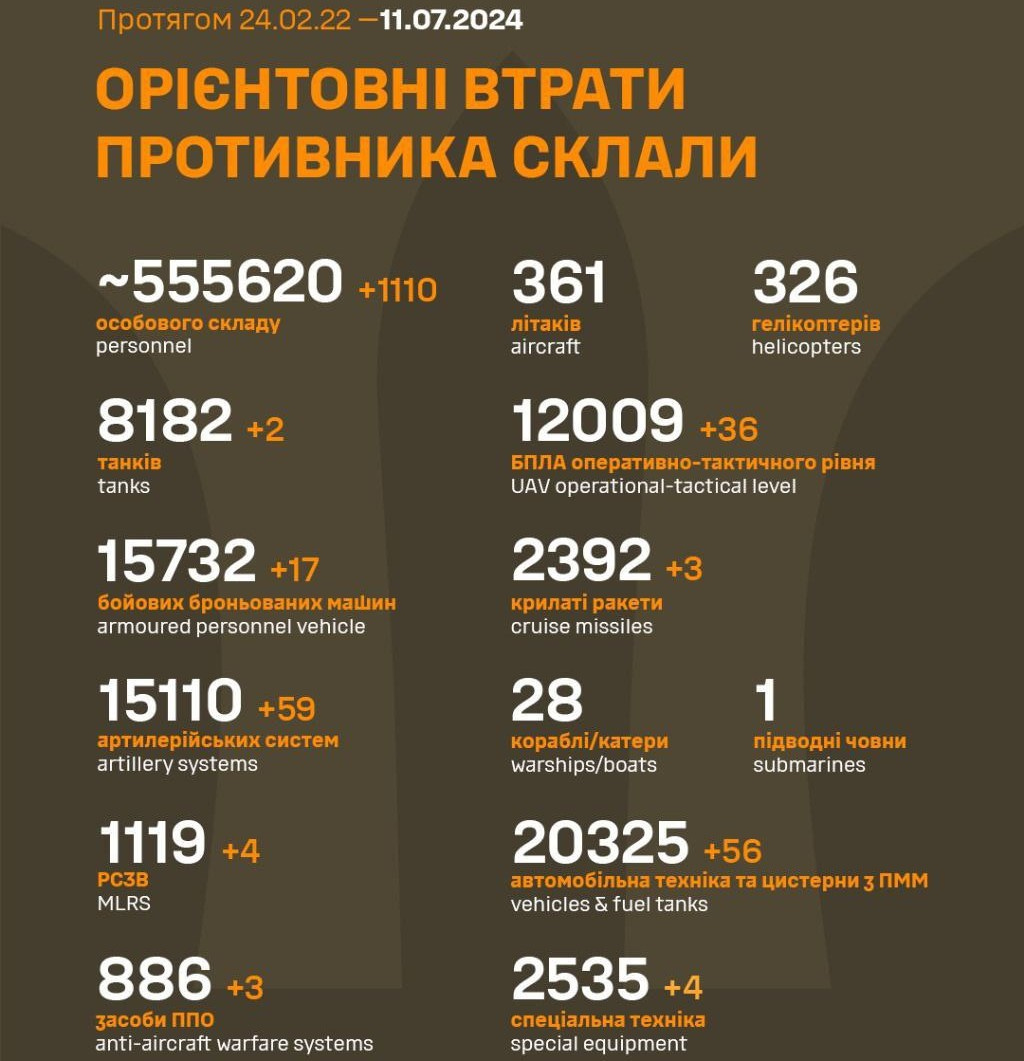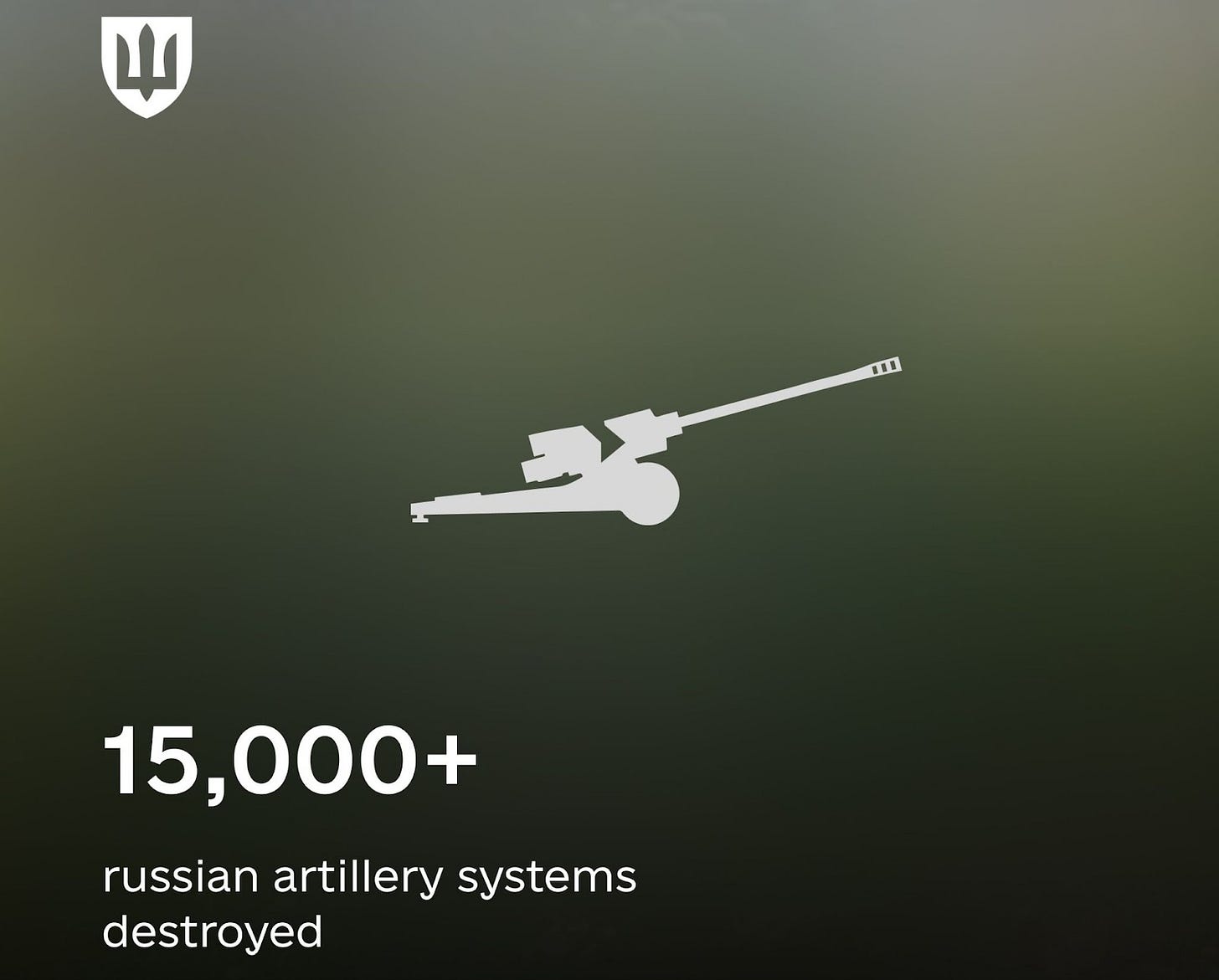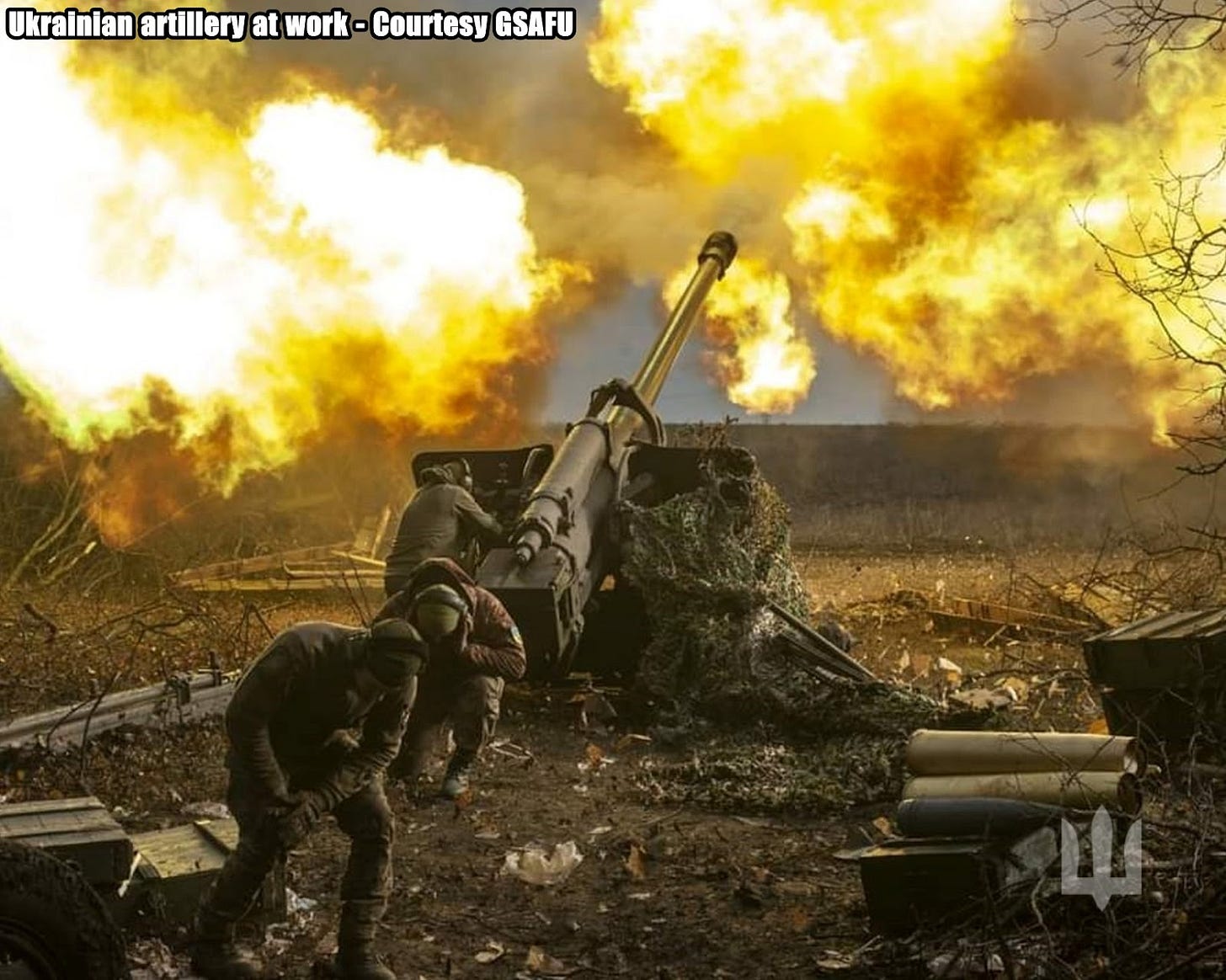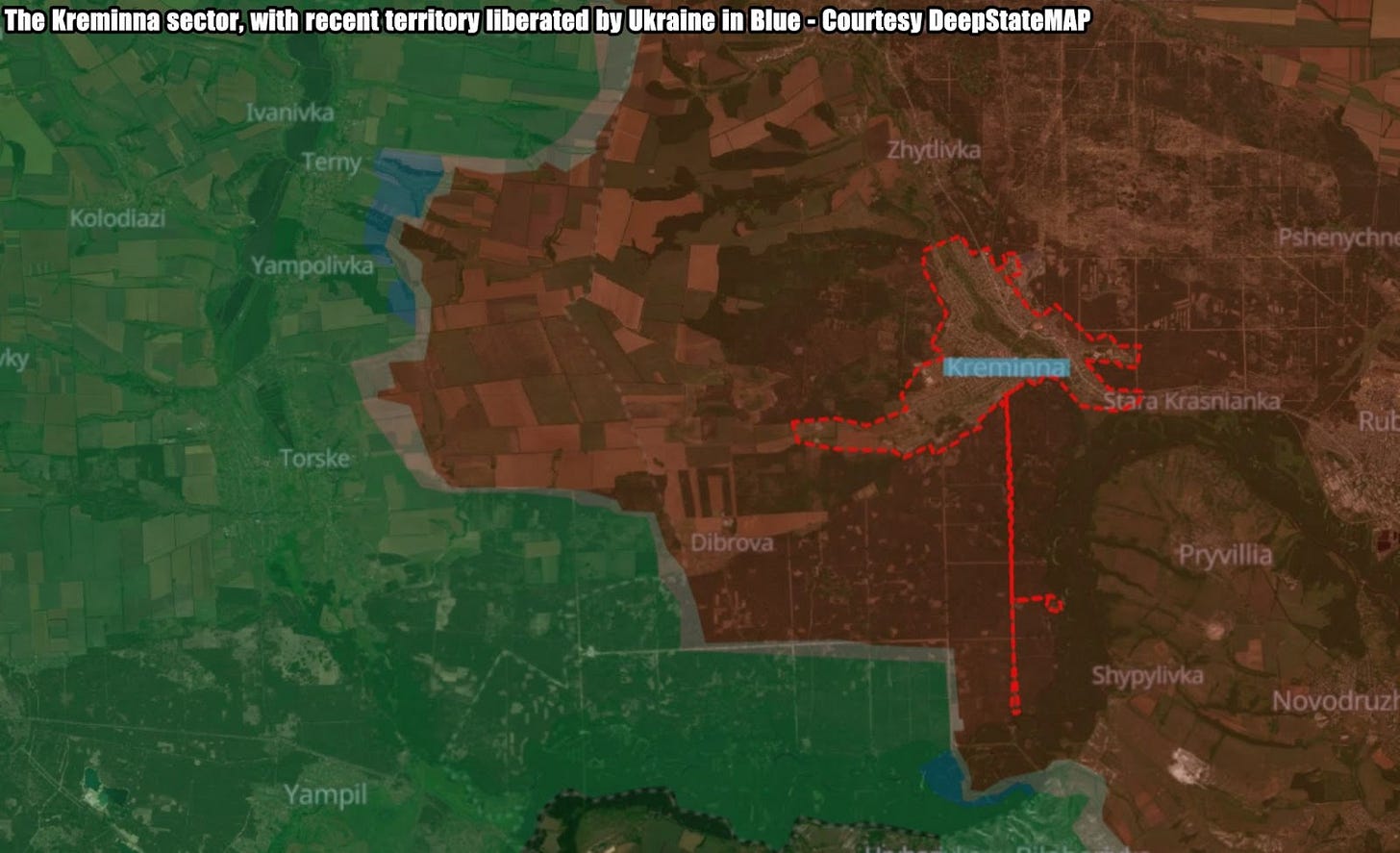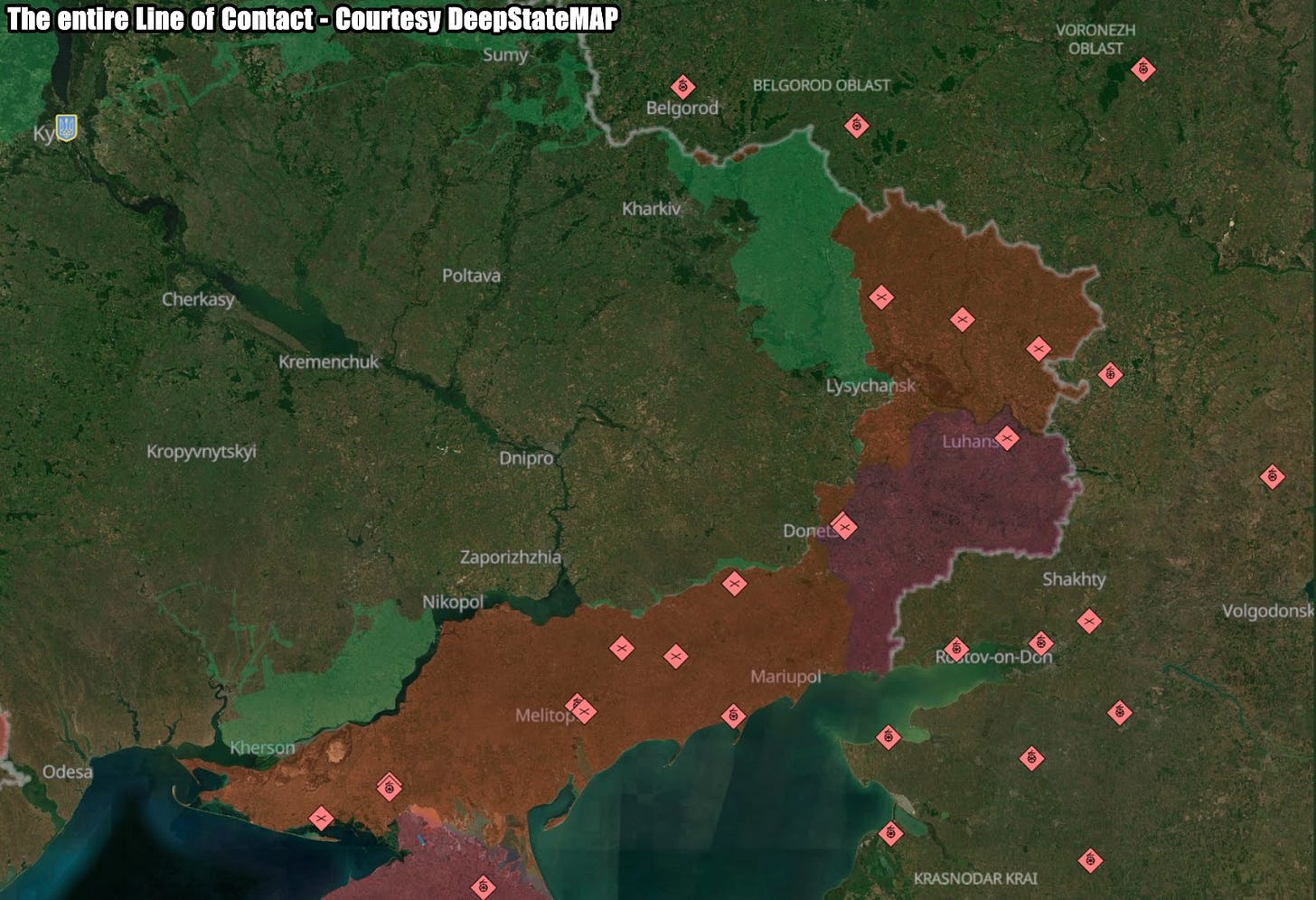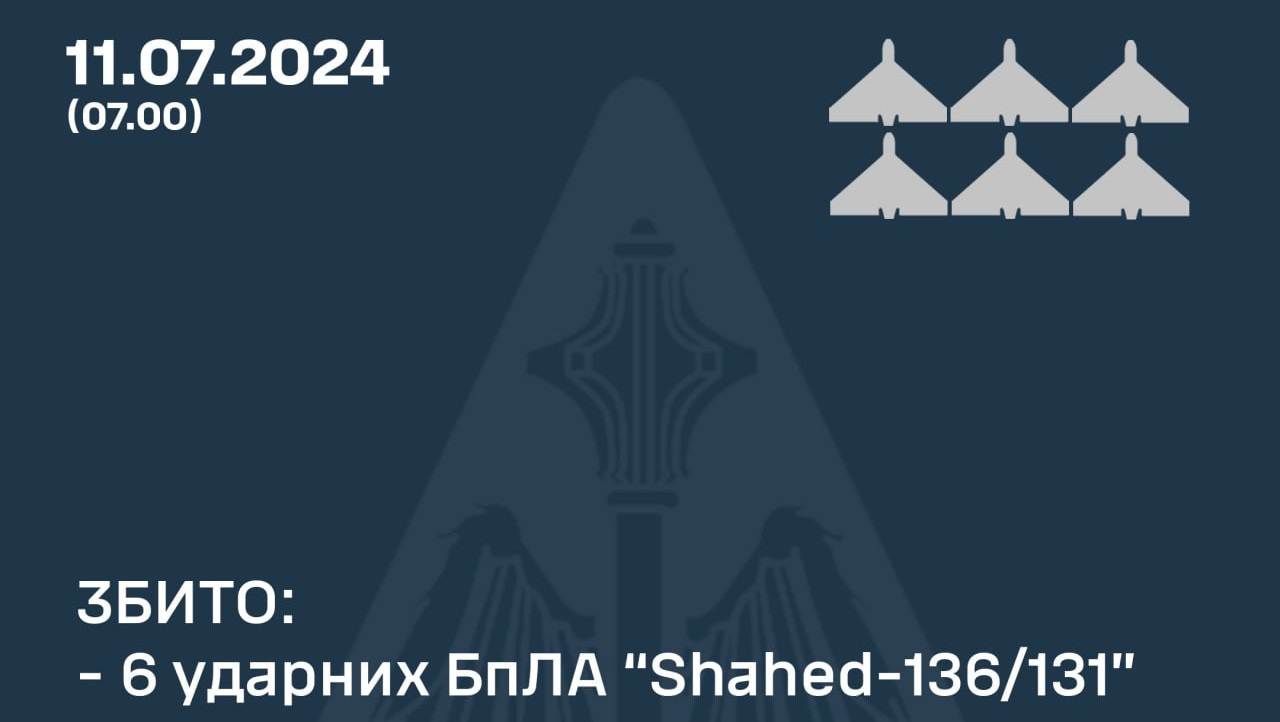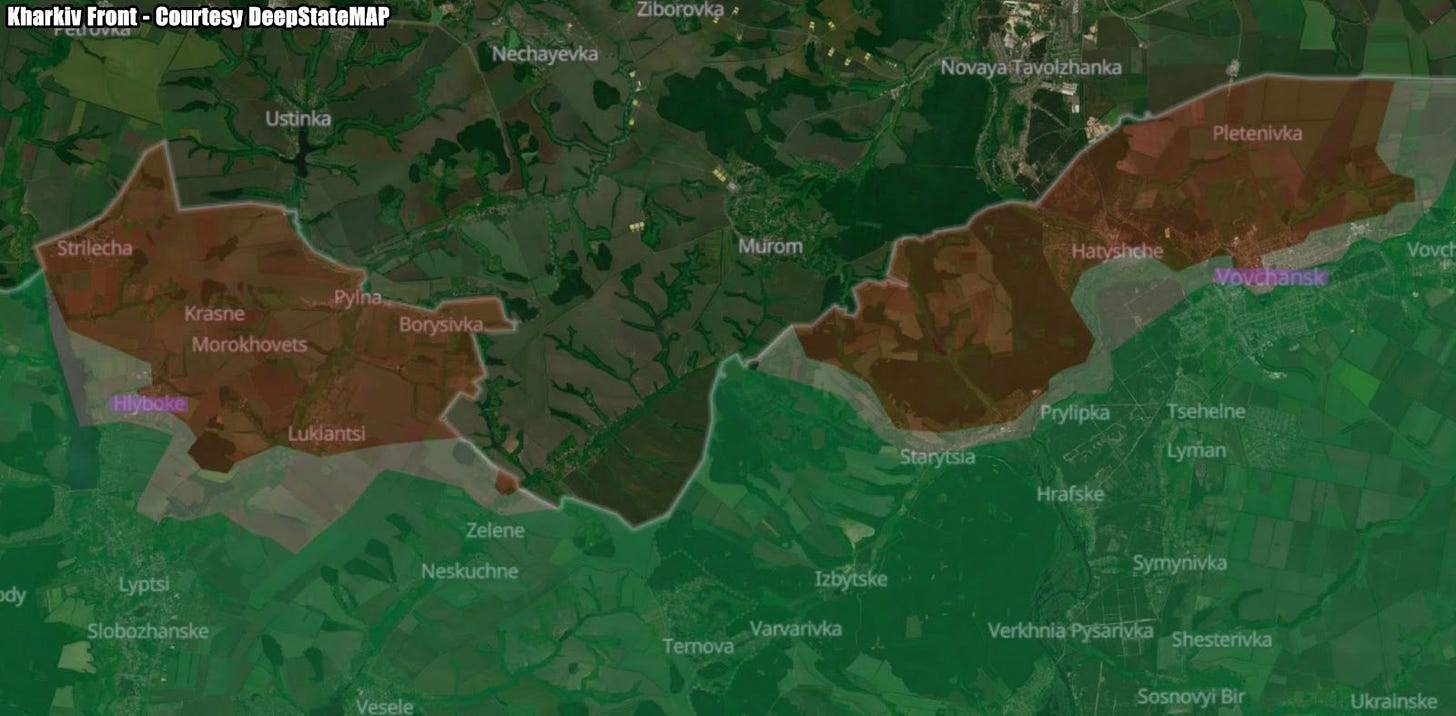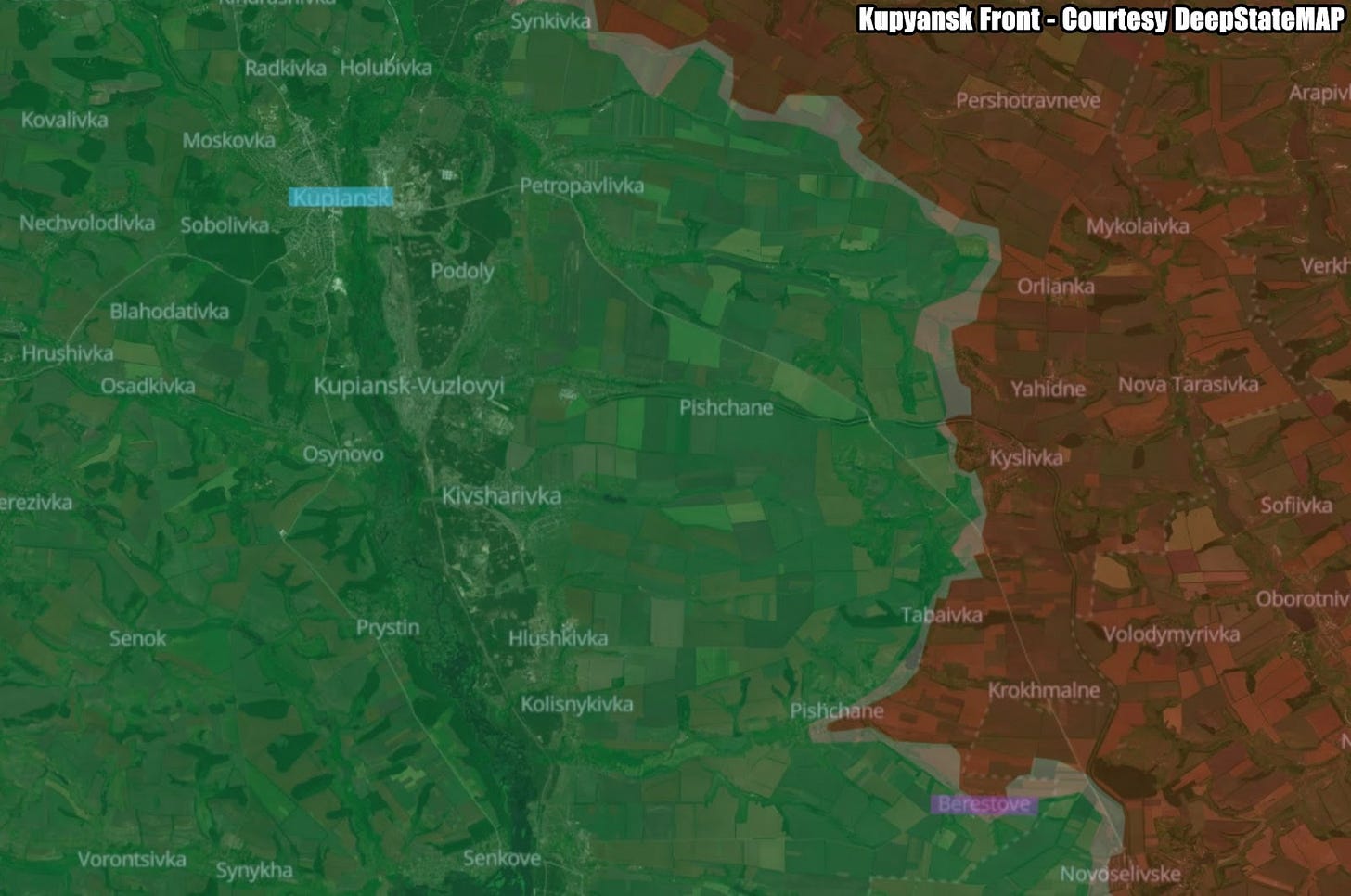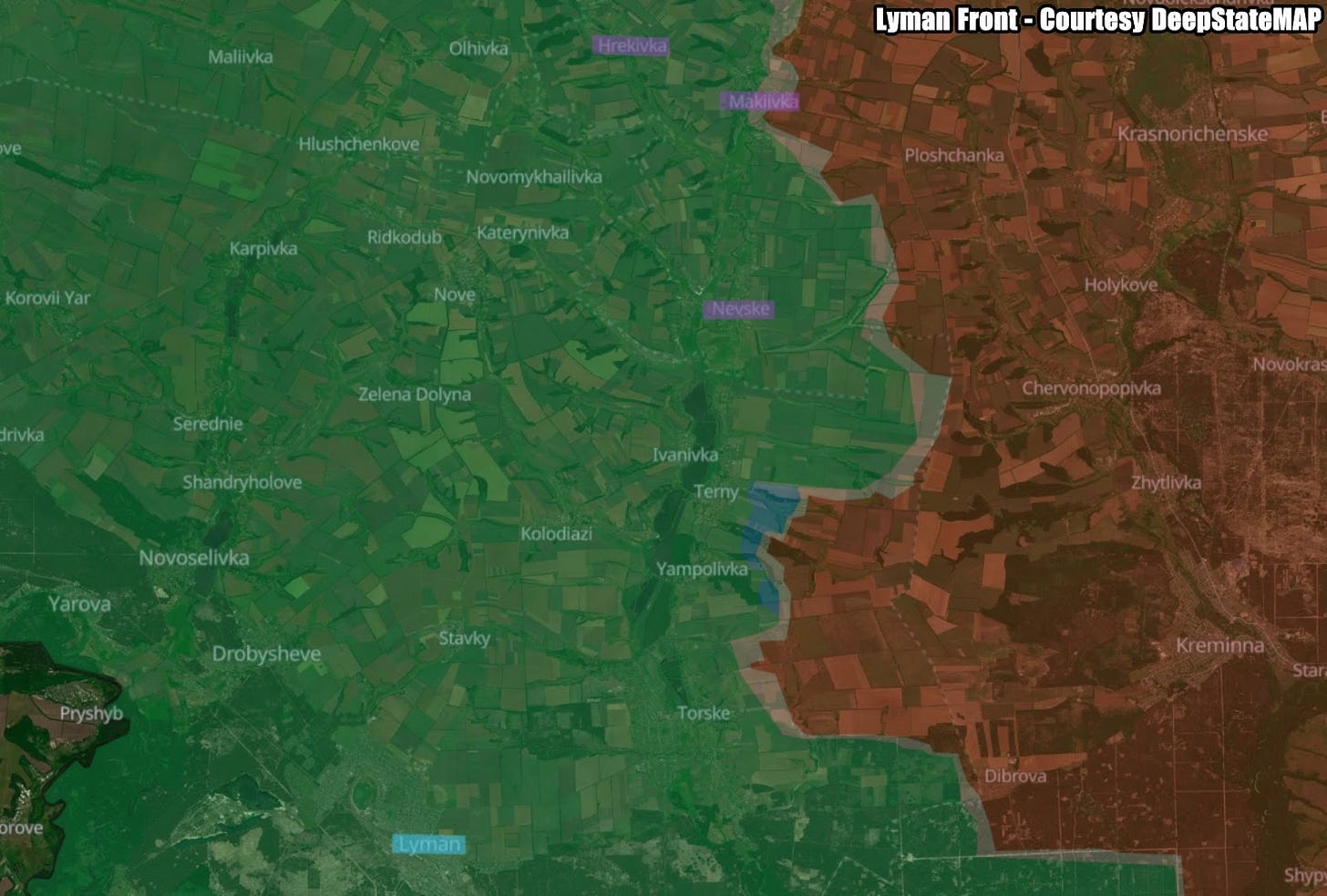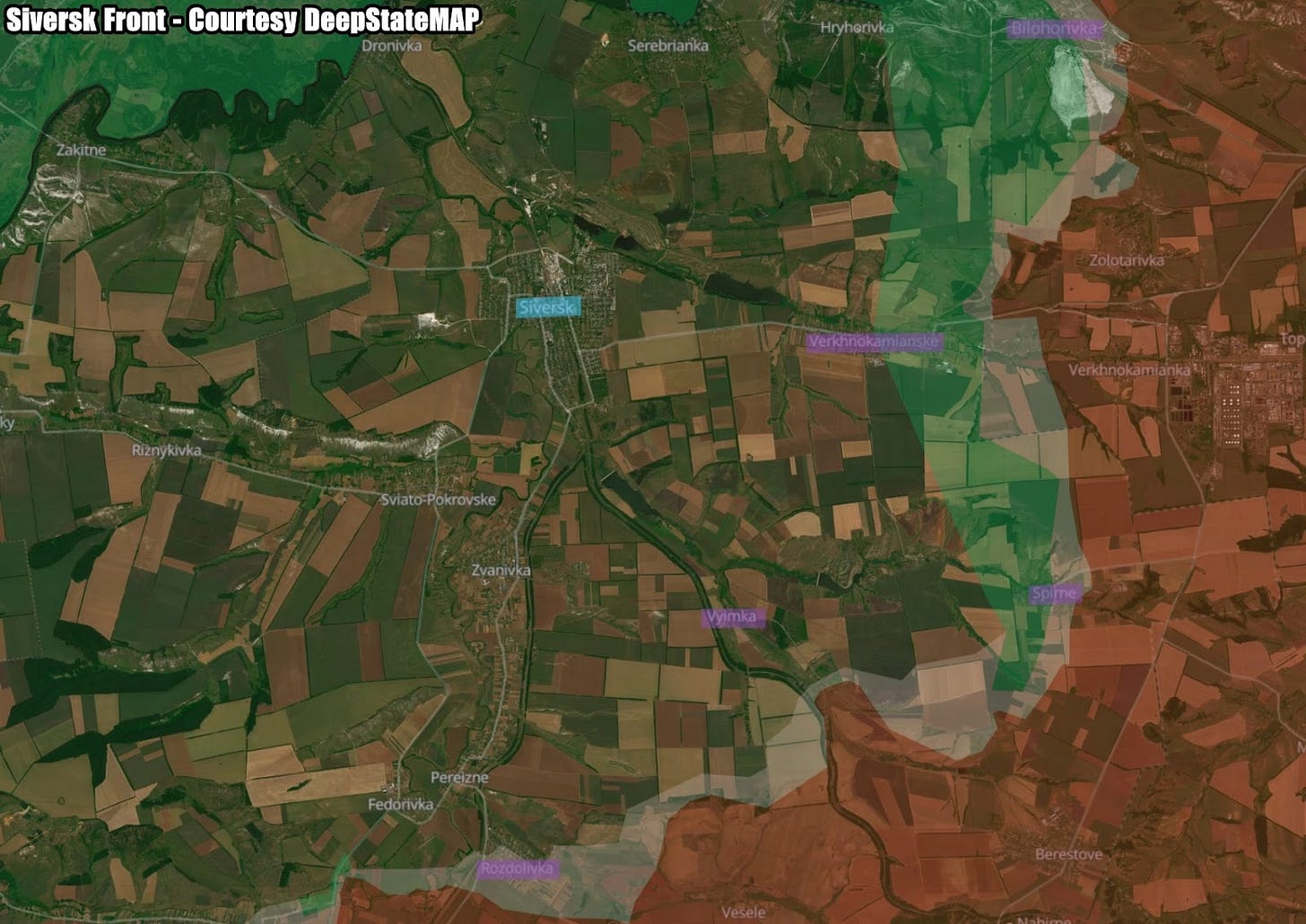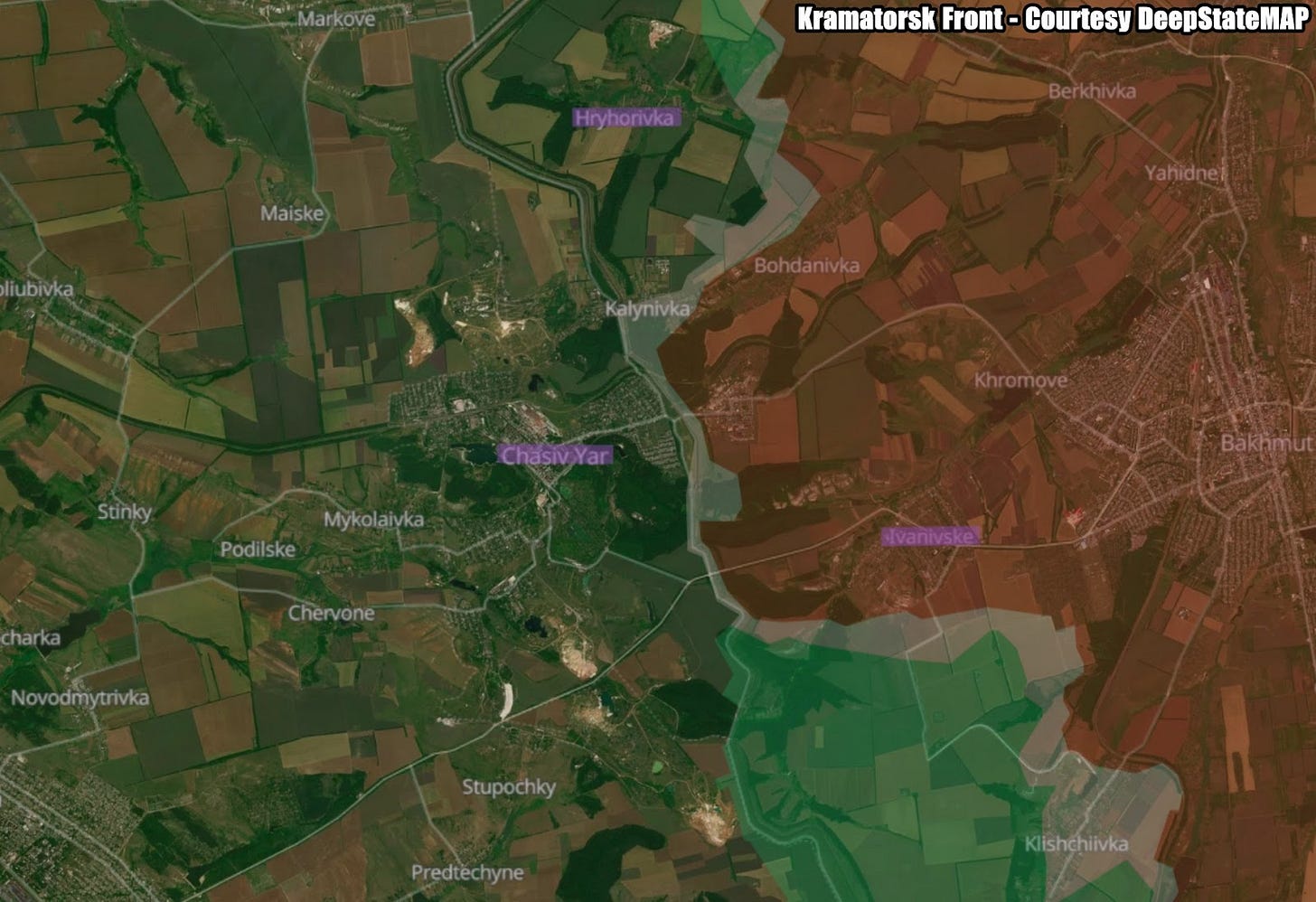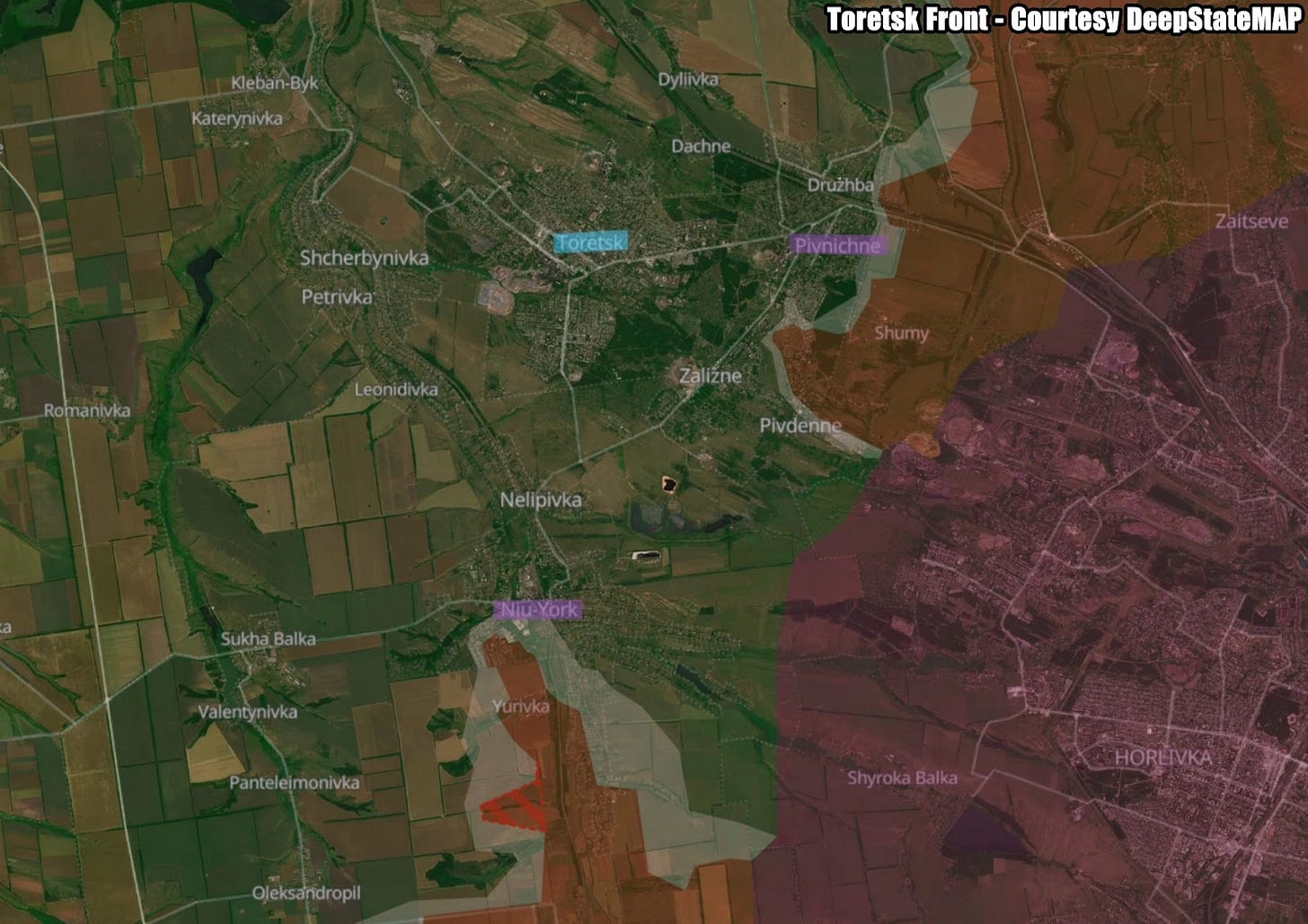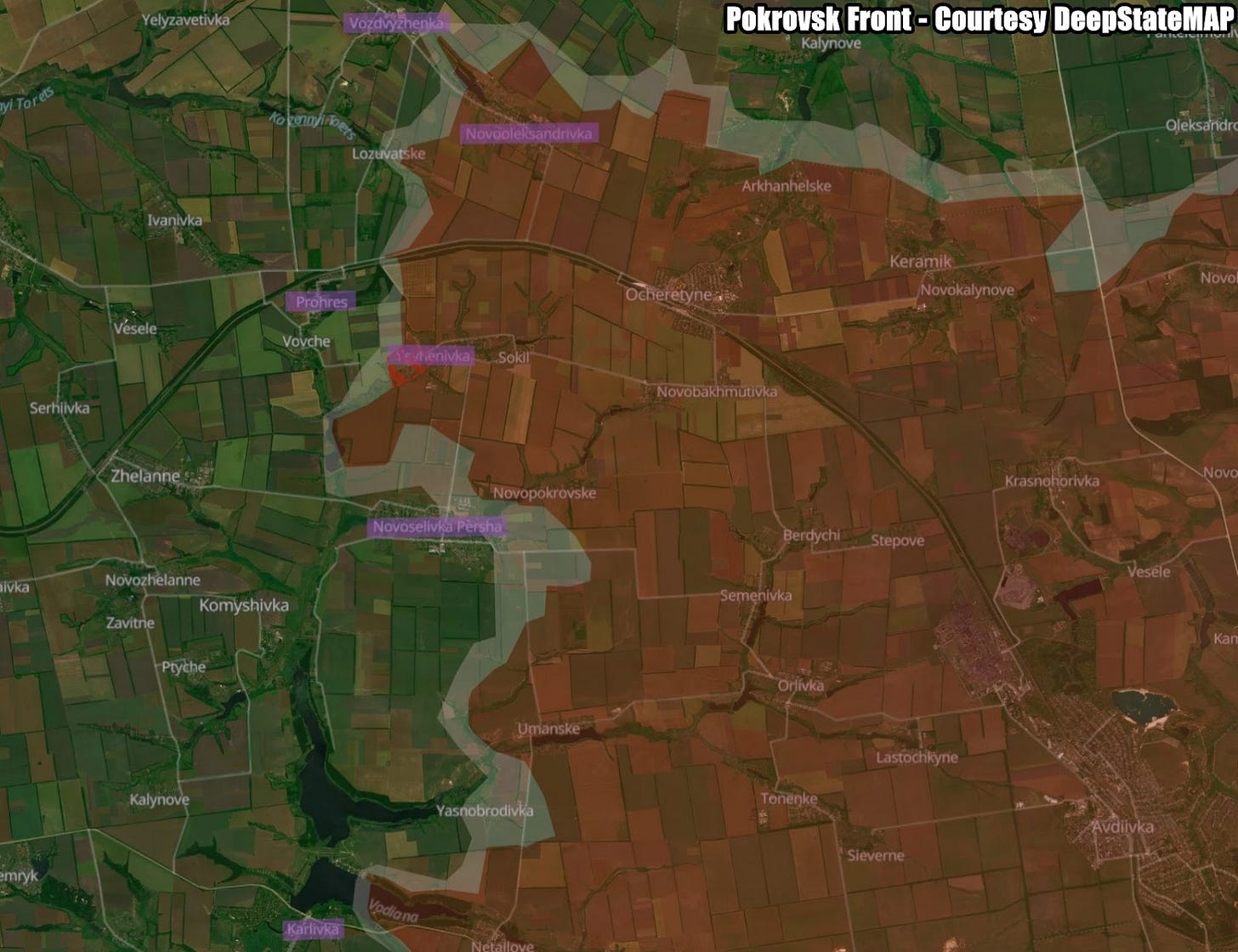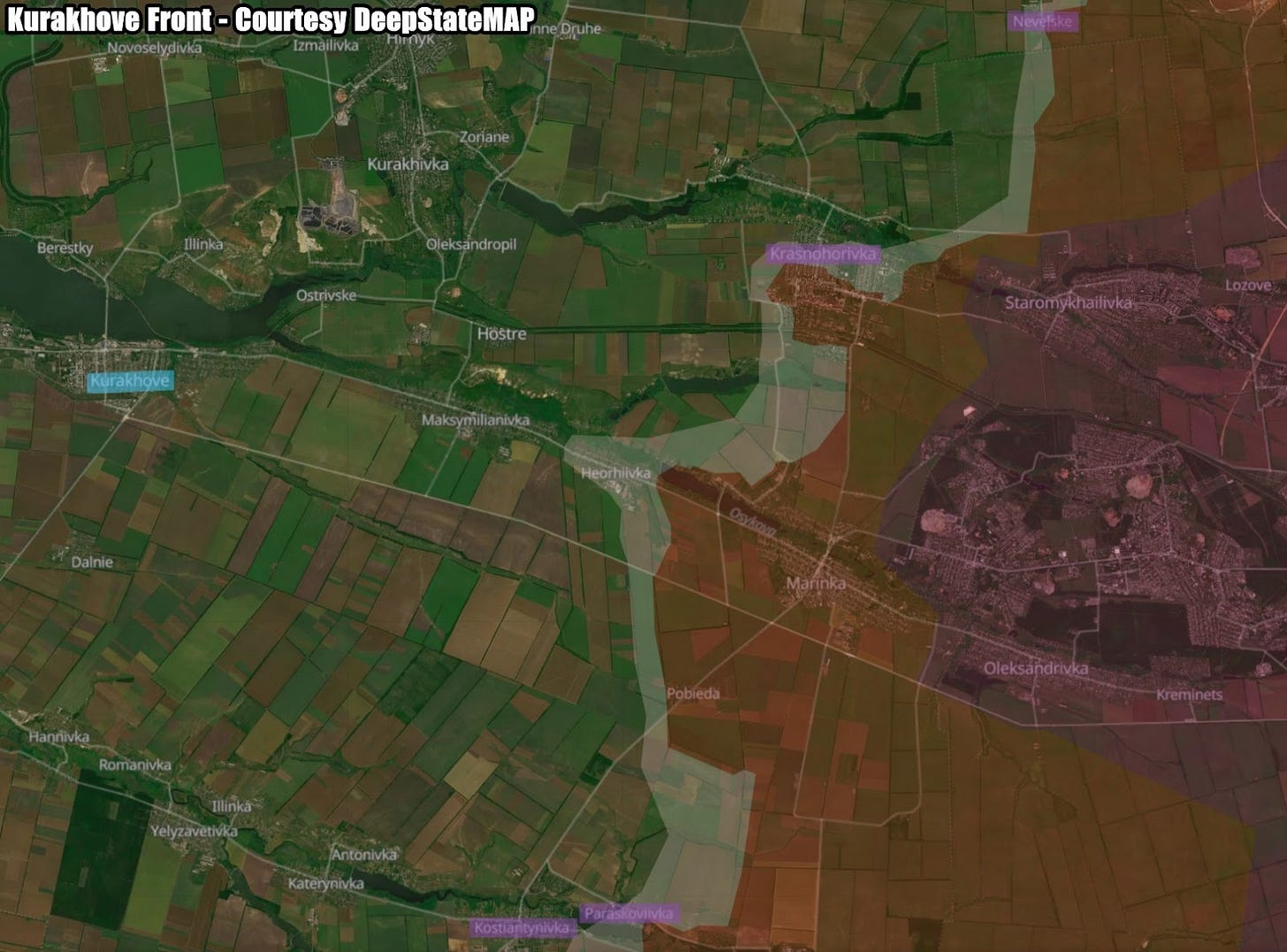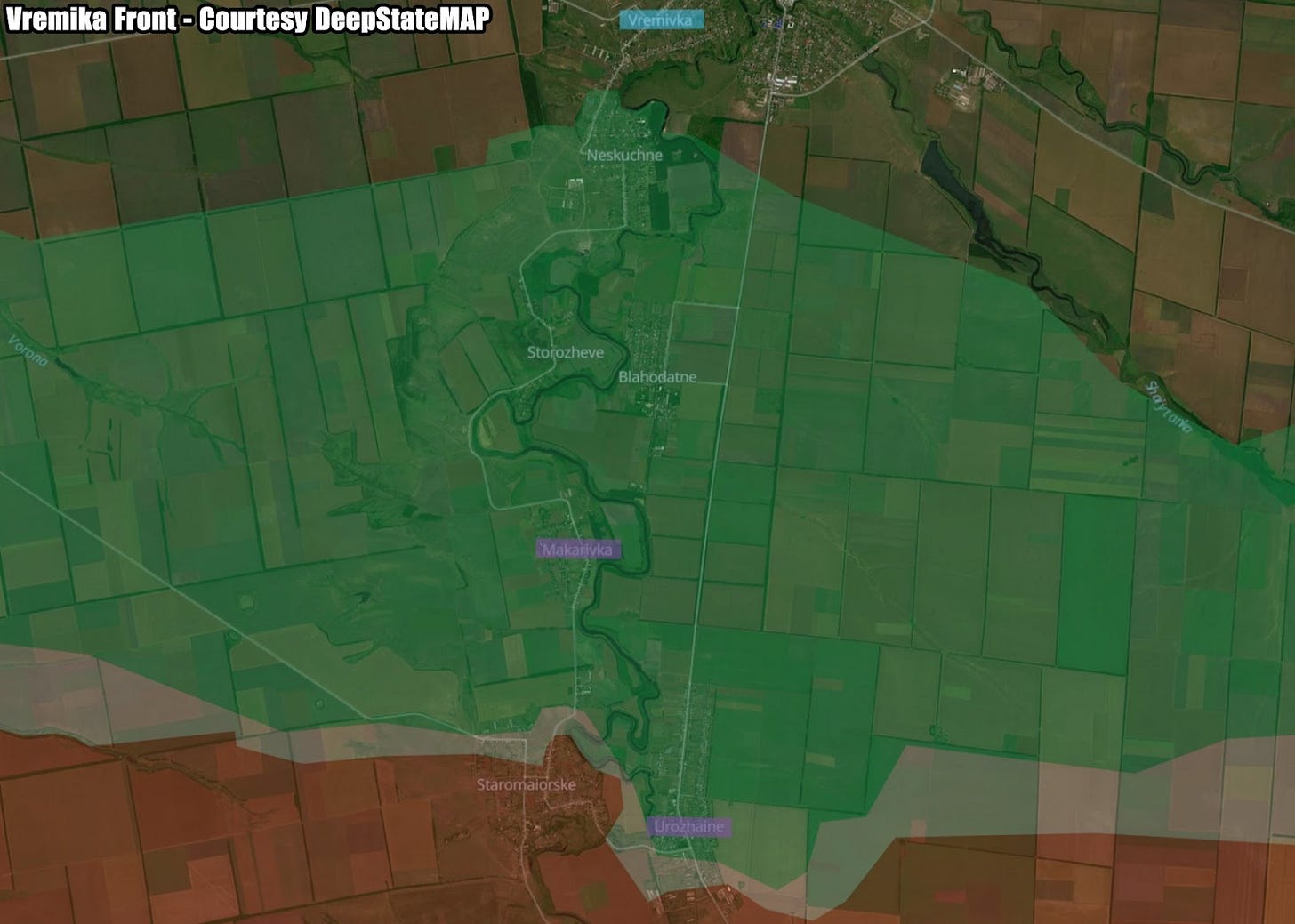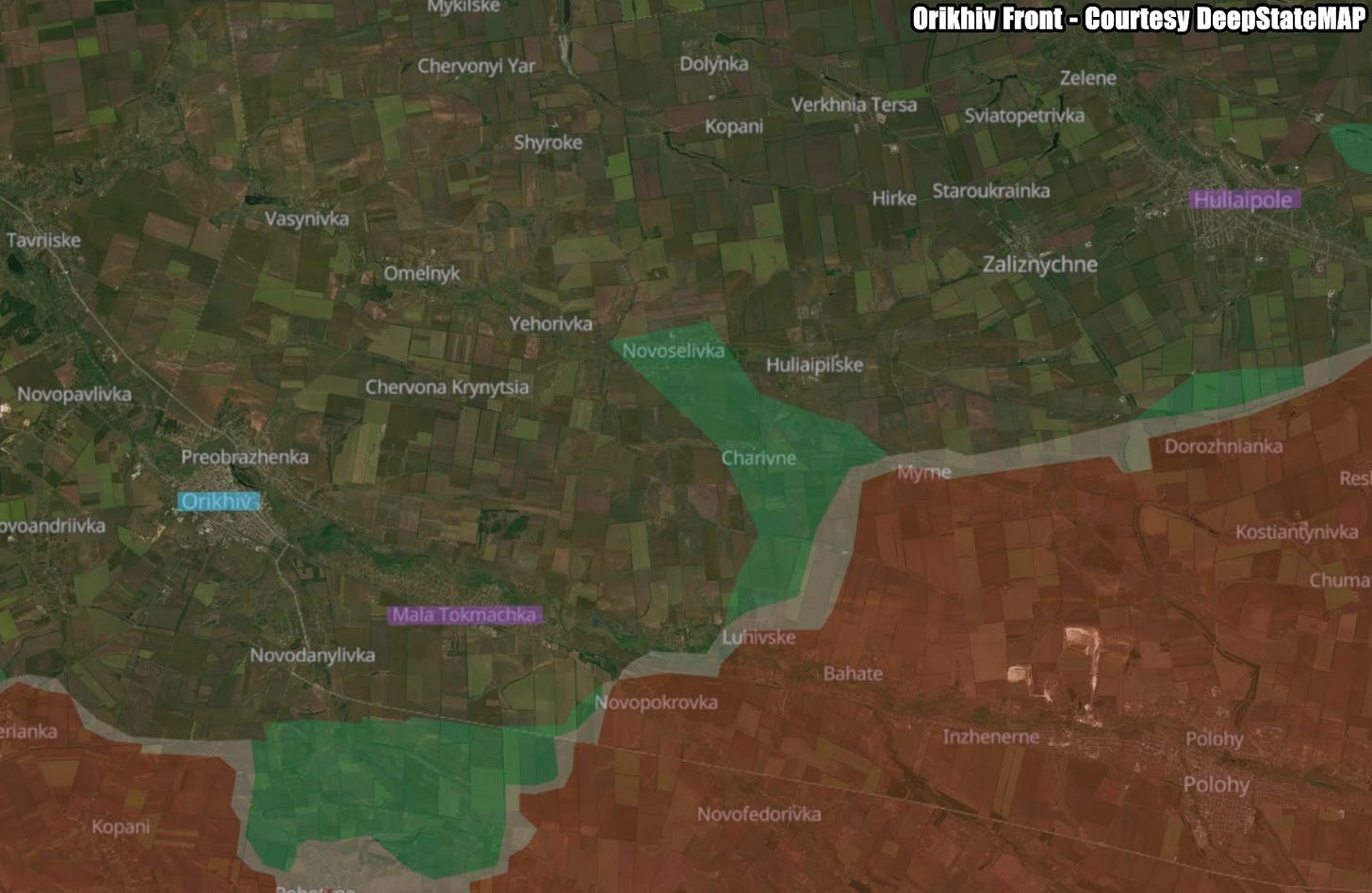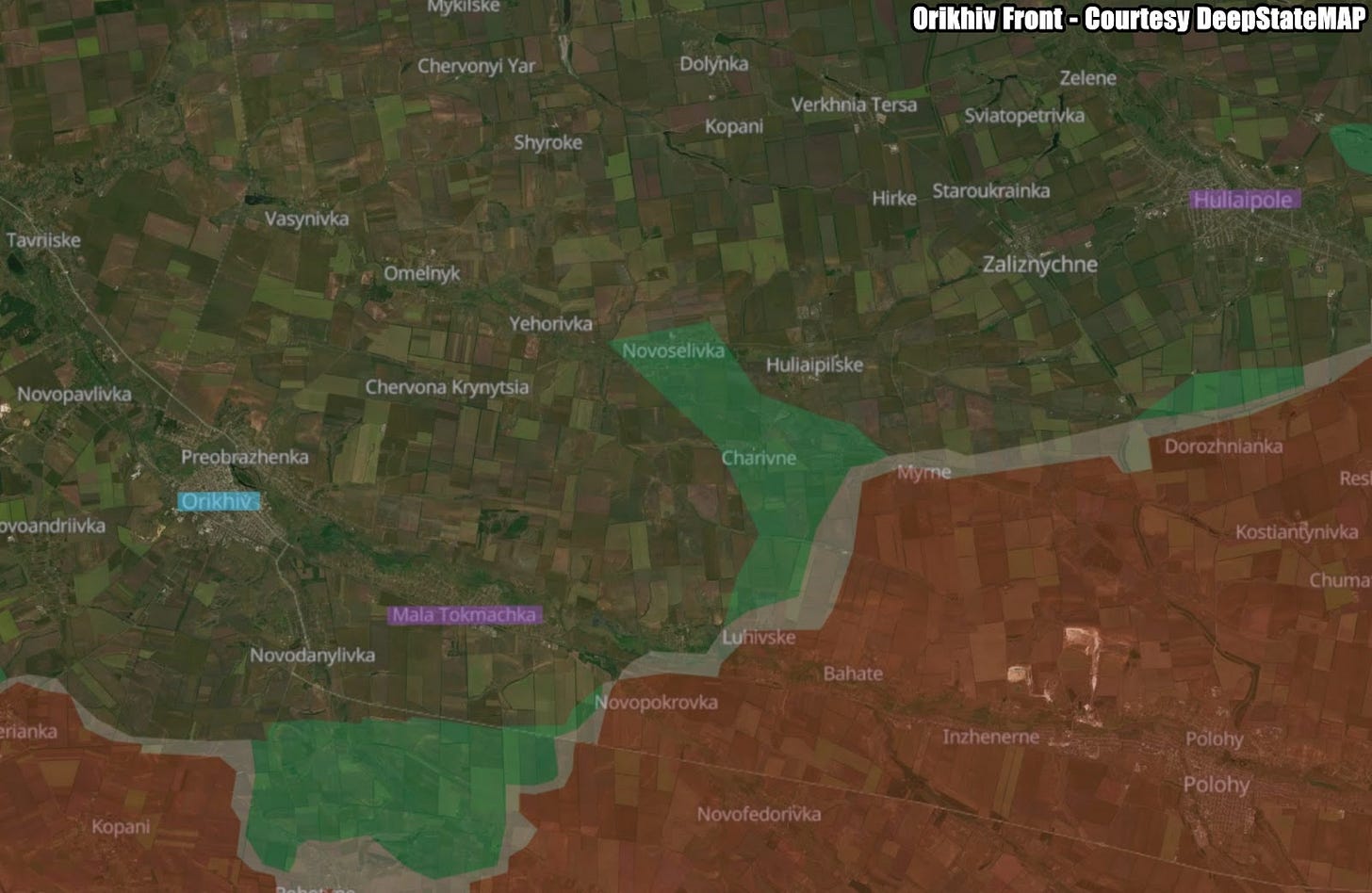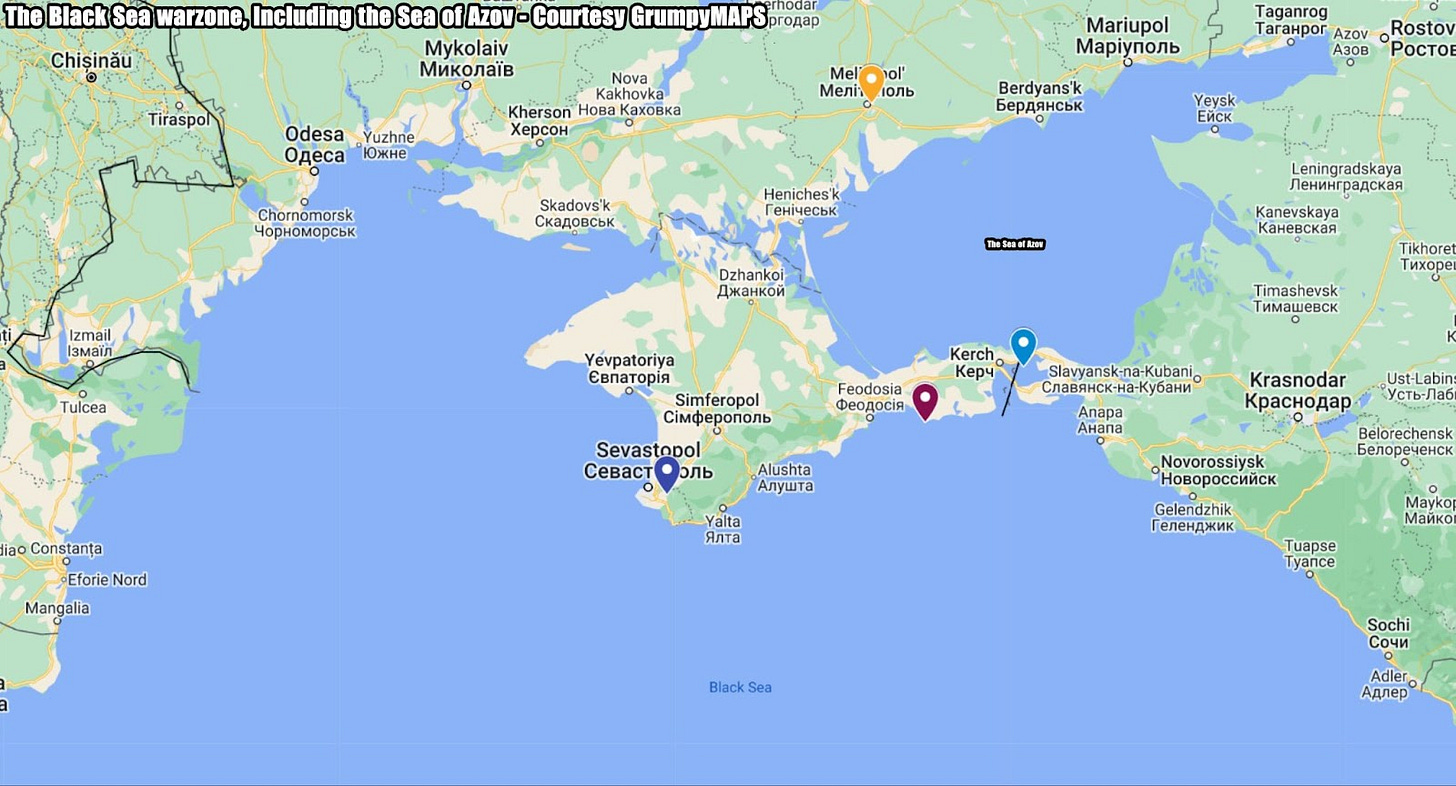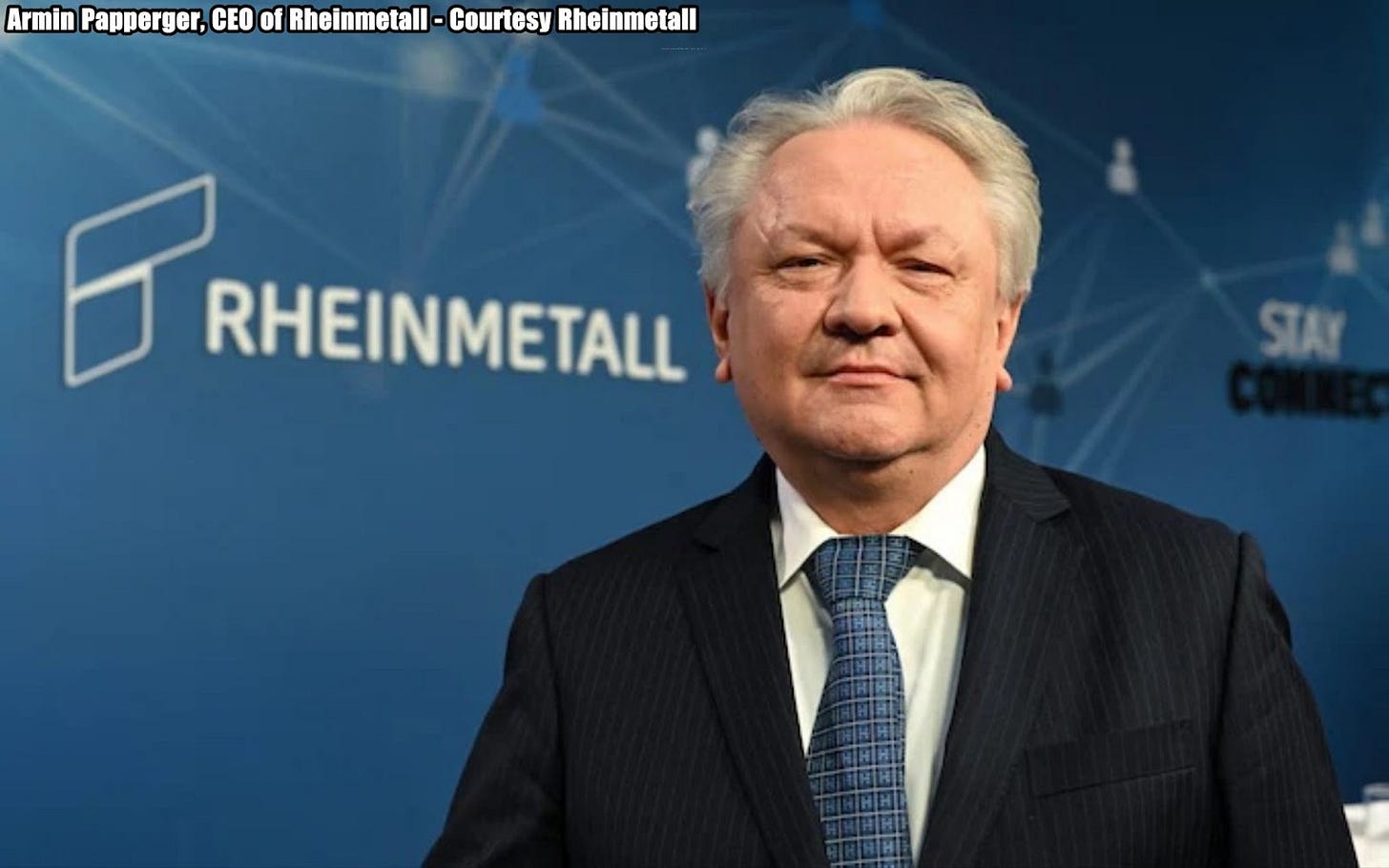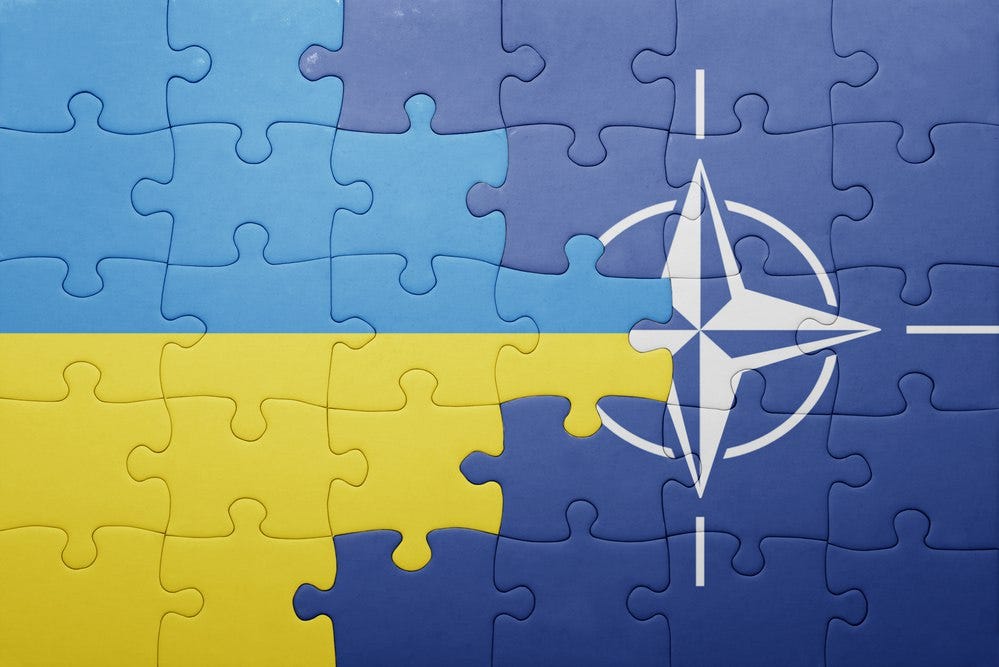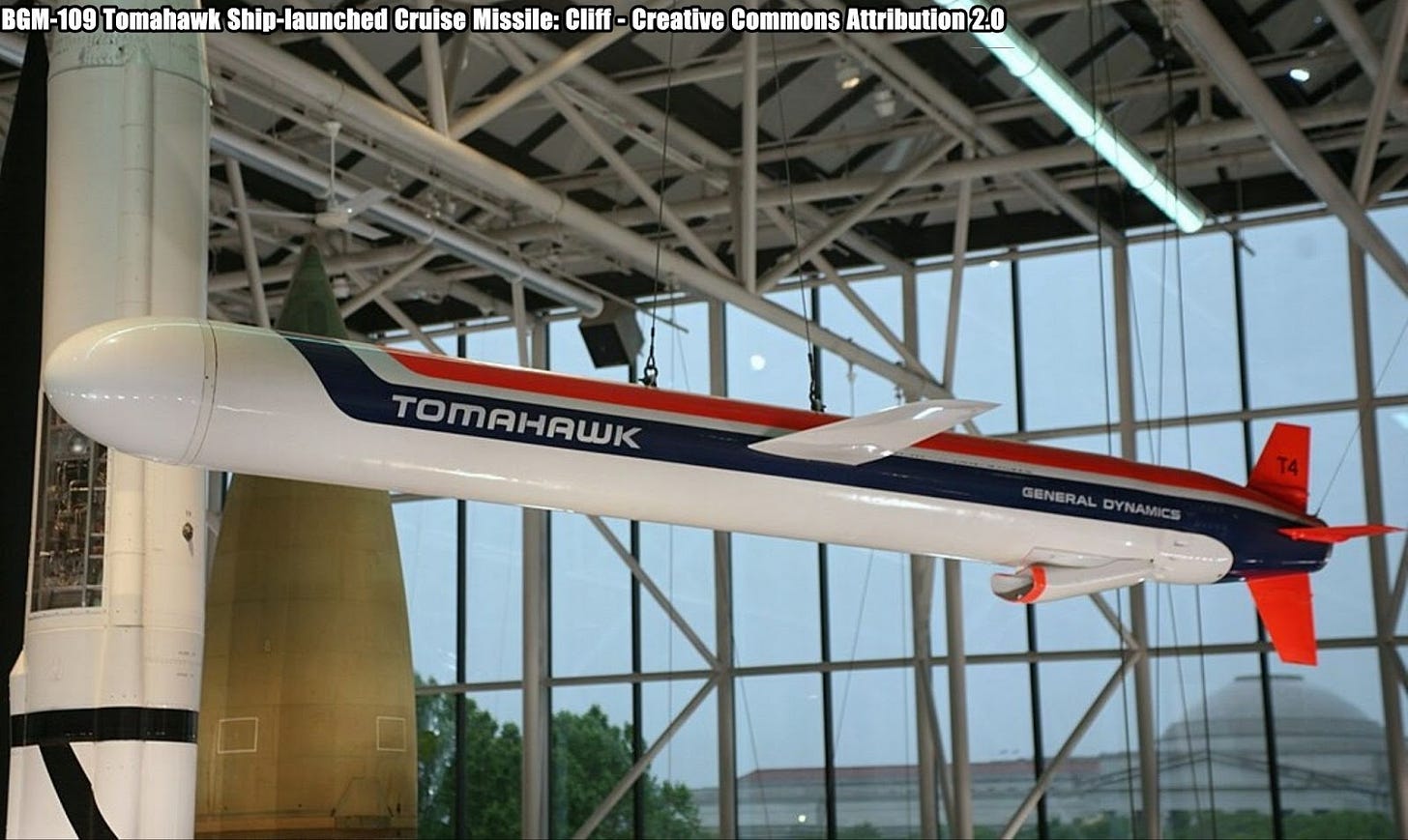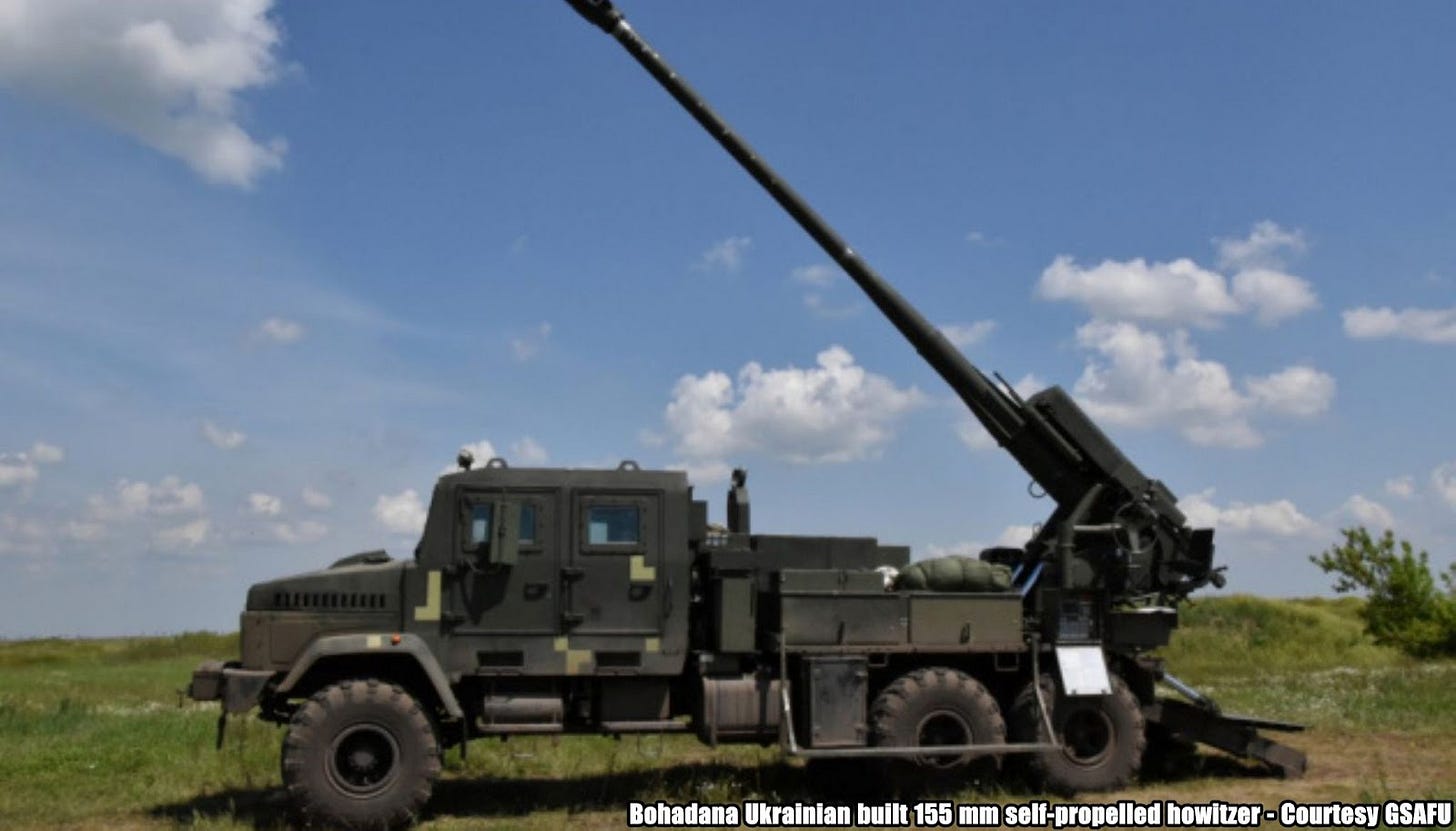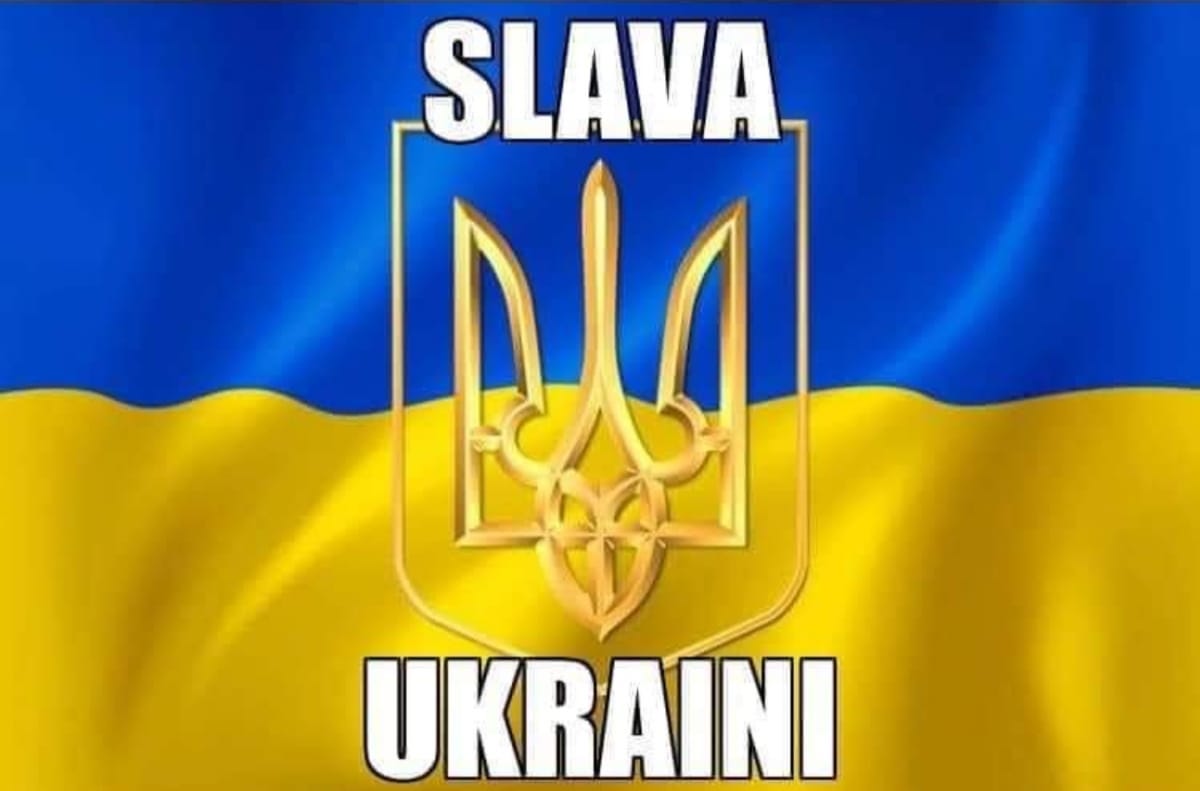Slava Ukraini! In early 2022 I began a Telegram channel aggregating news from a number of sources daily on the war in Ukraine. Since June 2023 I have provided a daily draft for the Ukraine War Brief Podcast collecting news from over 60 sources daily, much of which forms the basis of the script. While the Podcast is on hiatus I will make this Draft available here both on my own Substack and The People’s Media for those who wish to keep up with events on a daily basis.
ALONG THE CONTACT LINE
GSAFU Morning Report
The General Staff of the Armed Forces of Ukraine in its Operational Information update at 16:00 on July 10 Tomorrow will be day 868 of the full-scale invasion of the Russian Federation against Ukraine.
During the past day, 92 combat engagements took place. We apologise regarding the lack of detail in this report but the GSAFU’s website has not been updated since 16:00 hours yesterday.
Ukraine destroys more than 15,000 Russian artillery pieces
An important milestone was reached recently with Ukraine having destroyed more than 15,000 Russian artillery pieces.The GSAFU Congratulated AFU forces on their successful work in counter-battery fire
-
ISW - Momentum begins to swing on the front line
The Institute for the Study of War (ISW), a US based think tank stated in its July 10 Russian Offensive Campaign Assessment that Ukrainian forces are already attempting to contest the battlefield initiative in limited and localised counterattacks at the tactical level — emphasising that the current state of grinding positional warfare along the frontline is not an indefinitely stable one.
The arrival of Western-provided aid to the frontlines has allowed Ukrainian forces to stabilise critical areas of the front, and Ukrainian forces have conducted tactically significant and successful localised counterattacks in northern Kharkiv Oblast and towards Kreminna (in the Donetsk-Luhansk Oblast border area) starting in mid-May 2024.
Ukrainian forces are not yet conducting counterattacks at the scale necessary to seize the battlefield initiative, but these tactical Ukrainian counterattacks are increasing the costs imposed on Russian forces for continuing to pursue their slow, grinding theory of advance. For example, Ukrainian counterattacks in northern Kharkiv Oblast have forced Russian troops to redeploy select Russian elements away from where their centralised command formation should hypothetically be — ISW observed that Russia moved elements of the 810th Naval Infantry Brigade (Black Sea Fleet) and a battalion tactical group of the 9th Motorized Rifle Brigade (1st Donetsk People's Republic Army Corps) to northern Kharkiv Oblast in mid-June while other elements of the 810th Infantry and 9th Motorized Rifle brigades remained near Krynky, Kherson Oblast, and Toretsk, Donetsk Oblast respectively, where they had been fighting for some time
ISW also recently assessed that the Russian military command was separating and deploying elements of Russian Airborne (VDV) formations across the frontline — elements of the 106th VDV Division's 137th VDV Regiment are reportedly fighting in Kherson Oblast, while other elements of the regiment are fighting near Siversk, Donetsk Oblast.
The disparate deployment of elements of the same wider formation is a strong indicator that Russian forces are beginning to feel the pressure of Ukrainian counterattacks — emphasising that the frontline is not as static as Putin assesses it to be. Ukraine's ability to launch more powerful and organised counterattacks, however, continues to be contingent on sustained Western military support.
Air Force Daily Report
On the night of July 11, 2024, the enemy hit Sumy Oblast with two "Iskander-M" ballistic missiles from the Kursk region, and also attacked with 6 "Shahed-131/136" type UAVs from Primorsko-Akhtarsk - Russian Federation.
Enemy strike UAVs were shot down in Mykolaiv, Khmelnytskyi, Lviv and Ivano-Frankivsk regions.
Fighter aircraft, anti-aircraft missile units of the Air Force, and calculations of mobile fire groups of the Defense Forces of Ukraine were involved in combat operations.
The Khortytsia operational-strategic group
(Responsible for the northeastern part of Ukraine. )
Kharkiv axis: The enemy conducted 3 assault actions supported by aviation, in the areas of Hlyboke and Vovchansk.
Kupyansk axis: The enemy tried to advance 3 times against Ukrainian positions near Berestove. The situation is under control.
Lyman axis: Russian troops attacked Ukrainian defenders10 times in the areas of Hrekivka, Makiivka, Nevske Three attacks are ongoing. The situation is under control.
Siversk axis: Russian forces carried out 11 assaults in the vicinity of Bilhorivka, Verkhnokamianske, Sprine, Vyimka and Rozdolivka. 9 attacks have been repelled, 2 are ongoing.
Kramatorsk axis: The enemy attacked 5 times near the settlements of Hyrhorivka, Chasiv Yar and Ivanivske all attacks were suppressed.
Toretsk axis: The situation is tense in this direction. The invaders attacked 15 times unsuccessfully near Pivichne, Torestsk and Nui-York.
The Tavria operational-strategic group
(Responsible for the central-eastern and southeastern part of Ukraine.)
Pokrovsk axis: The highest intensity of combat remains in this sector. The enemy conducted 31 attacks against Ukrainian defences in this area over the last day in the vicinity of Vozdvizhenka, Novooleksandrívka, Prohes, Yevhenívka, Novoselivka Persha and Karlivka.
Kurakhove axis: The enemy 6 times unsuccessfully attacked our positions near Nevelske, Krasnohorivka, Heorgievka, Paraskovievka and Konstantinivka.
Vremika axis: The Russians conducted 3 offensive actions near Urozhaine and Makarivka.
Orikhiv axis: The enemy made 2 attacks in the vicinity of Mala Tokmachka and Hulyaipole.
The Odesa operational-strategic group
(Responsible for Kherson, Qırım, (also known as Crimea) and the Black Sea.)
Prydniprovsk axis: In this direction, the situation has not changed significantly. The enemy conducted 2 unsuccessful assault actions on the left bank of the Dnieper in the vicinity of Krynky.
UK Intel - Ukraine has destroyed or damaged 26 Russian Navy vessels
The UK Ministry of Defence in its July 10 Intelligence Update on Ukraine stated that open source reporting has highlighted that Ukrainian forces have destroyed or damaged 26 Russian Navy vessels operating in the Black Sea region between Feb. 2022 and June 2024. Strikes have occurred across the northern portion of the Black Sea and within the Sea of Azov.
There has been an increase in the frequency and level of damage caused by attacks around the Crimean Peninsula over the last year, with nearly two thirds of the strikes occurring within this period.
TEMPORARILY OCCUPIED TERRITORIES
Nothing to report.
THE HOME FRONT
Kyiv hospital took direct hit from Russian missile, UN analysis suggests
A U.N. human rights mission said on Tuesday there was a "high likelihood" that Kyiv's main children's hospital took a direct hit from a Russian missile during a series of airstrikes on Ukrainian cities, as the Kremlin continued to deny involvement. Reuters reported.
Ukraine flew its flags at half mast in a national day of mourning to mark the deaths of 44 people across the country from Monday's air attacks, including four children and two adults at the Okhmatdyt children's hospital in the capital.
"Analysis of the video footage and an assessment made at the incident site indicates a high likelihood that the children's hospital suffered a direct hit rather than receiving damage due to an intercepted weapon system," said Danielle Bell, head of the U.N. Human Rights Monitoring Mission in Ukraine.
The Kremlin said, without providing evidence, it was Ukrainian anti-missile fire, not Russia, that hit the children's hospital, which is one of Europe's largest and treats patients with serious conditions such as cancer and kidney disease.
Damage at the site prompted millions of dollars in donations from inside Ukraine and abroad, more than 28 months into Russia's full-scale invasion. Eight children were wounded at the hospital, health authorities said.
RUSSIAN WORLD
US, Germany disrupted Russian plot to assassinate Rheinmetall CEO
US intelligence discovered earlier this year that the Russian government planned to assassinate the chief executive of a powerful German arms manufacturer that has been producing artillery shells and military vehicles for Ukraine, according to five US and western officials familiar with the episode. CNN reported.
The plot was one of a series of Russian plans to assassinate defence industry executives across Europe who were supporting Ukraine’s war effort, these sources said. The plan to kill Armin Papperger, a white-haired goliath who has led the German manufacturing charge in support of Kyiv, was the most mature.
When the Americans learned of the effort, they informed Germany, whose security services were then able to protect Papperger and foil the plot. A high-level German government official confirmed that Berlin was warned about the plot by the US.
For more than six months, Russia has been carrying out a sabotage campaign across Europe, largely by proxy. It has recruited local amateurs for everything from arson attacks on warehouses linked to arms for Ukraine to petty acts of vandalism — all designed to stymie the flow of weapons from the West to Ukraine and blunt public support for Kyiv.
The series of plots, not previously reported, helps explain the increasingly strident warnings from NATO officials about the seriousness of the sabotage campaign — one that some senior officials believe risks crossing the threshold into armed conflict in eastern Europe.
“We’re seeing sabotage, we’re seeing assassination plots, we’re seeing arson. We’re seeing things that have a cost in human lives,” a senior NATO official told reporters on Tuesday. “I believe very much that we’re seeing a campaign of covert sabotage activities from Russia that have strategic consequences.”
NSC spokesperson Adrienne Watson said in a statement, “Russia’s intensifying campaign of subversion is something that we are taking extremely seriously and have been intently focused on over the past few months.
“The United States has been discussing this issue with our NATO Allies, and we are actively working together to expose and disrupt these activities,” she said. “We have also been clear that Russia’s actions will not deter Allies from continuing to support Ukraine.”
NEWS WORLDWIDE
Ukraine is on an ‘irreversible’ path to NATO. But only after war with Russia ends
The 32-members of NATO on Wednesday formally declared Ukraine on an “irreversible” path to membership in the Western military alliance, offering a bare but more binding assurance of protection once its war with Russia ends. AP reports.
NATO member countries individually and in Wednesday’s joint statement from their summit in Washington announced a series of steps aimed at bolstering Ukraine’s defences. That includes the U.S., the Netherlands and Denmark announcing that the first NATO-provided F-16s would be in the hands of Ukrainian military pilots by this summer.
Ukrainian President Volodymyr Zelenskyy tweeted his appreciation of the effort to strengthen his air force, coming soon after Ukraine saw one of the deadliest strikes of the war.
NATO on Wednesday also announced a long-term commitment of security assistance to Ukraine, and confirmed establishment of a new NATO centre aimed at ensuring that Ukraine gets a more reliable flow of arms and training from members of the alliance. But the commitments still fall short of the striking power Ukraine says it needs to defeat the invading Russian forces.
US cruise missiles to return to Germany, angering Moscow
Long-range US missiles are to be deployed periodically in Germany from 2026 for the first time since the Cold War, in a decision announced at Nato's 75th anniversary summit. BBC reports.
The Tomahawk cruise, SM-6 and hypersonic missiles have a significantly longer range than existing missiles, the US and Germany said in a joint statement.
Such missiles would have been banned under a 1988 treaty between the US and former Soviet Union, but the pact fell apart five years ago.
Russian Deputy Foreign Minister Sergei Ryabkov said Moscow would react with a "military response to the new threat".
"This is just a link in the chain of a course of escalation," he argued, accusing Nato and the US of trying to intimidate Russia.
The joint US-German statement made clear the "episodic" deployment of the missiles was initially seen as temporary but would later become permanent, as part of a US commitment to Nato and Europe's "integrated deterrence".
German Defence Minister Boris Pistorius, who was speaking at the Nato summit in Washington, said the idea behind the US plan was to encourage Germany and other European countries to put their own investment into developing and procuring longer-range missiles.
The temporary deployment of US weapons would give Nato allies the time to prepare, he explained: "We are talking here about an increasingly serious gap in capability in Europe."
MILITARY & TECH
Denmark orders 18 Bohdana self-propelled howitzers for Ukrainian forces
Ukraine's defence forces will receive 18 Bohdana self-propelled artillery systems financed by Denmark in the next few months. Ukrinform reports.
The Ukrainian Defense Ministry announced this on the social media platform X, Ukrinform reports.
"The first donation of 18 Bohdana artillery systems financed by Denmark is expected to be delivered within the coming months," the ministry said.
The Ukrainian Defense Ministry also thanked Denmark for its assistance to Ukraine. "We are grateful to our Danish friends for their staunch support. We are stronger when we unite!" the post reads.
Earlier reports said that Denmark is the first NATO country to directly finance Ukrainian production of arms and ammunition.
That’s it for today’s Draft folks if you would like to keep up with events in Ukraine daily please consider subscribing, its free!
Feel free to share this update with your friends. Heroyam Slava!







